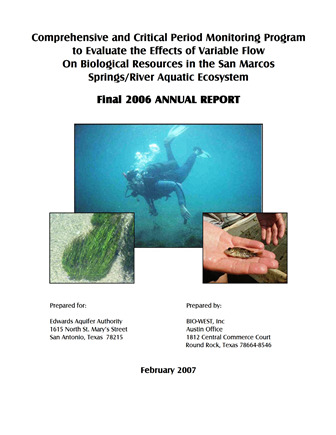Comprehensive and Critical Period Monitoring Program to Evaluate the Effects of Variable Flow on Biological Resources in the San Marcos Springs/River Aquatic Ecosystem Final 2006 Annual Report

| Summary |
|
The purpose of this report is to document the results of all aquatic ecosystem monitoring conducted in 2006 at San Marcos Springs located in San Marcos, Texas. The monitoring and report preparation was performed by BIO-WEST, Inc. Pflugerville, Texas. [Excerpted from the Executive Summary] The extended period of limited recharge leading up to and extending throughout 2006 caused discharge in the San Marcos River to decline to levels not experienced since 1996. When reviewing the annual discharge in the San Marcos River since the installation of the USGS gage in fall 1956, the 2006 average annual discharge of 112 cfs was the eighth lowest on record. … Water Quality grab samples were collected at multiple sites in Spring Lake and the San Marcos River to evaluate select parameters during the two Critical Period sampling events…. Total Suspended Solids (TSS) were low at all sites in Spring Lake, and showed an increasing trend in the San Marcos River between Critical Period events. Nitrate values at the Spring Lake and San Marcos River sites were higher than the average from 2000-2002 for Critical Period 1 with the source of these nitrates most likely water coming out of the springs. … A general trend of decreasing vegetation area was observed at the Spring Lake Dam site in 2006. At the mouth of Sessom’s Creek a large “island” developed as a result of large sediment loads carried by this flashy stream. This “new” bank was mapped and resulted in a loss of available area for vegetation growth in the Spring Lake Dam Reach. By the first Critical Period event, much of the vegetation had decreased in the vicinity of this “island”. Another considerable loss of vegetation occurred in this reach in September, when approximately 234 m2 of Texas wild-rice was manually pulled out along the eastern shore of the Spring Lake Dam Reach…. It is clear that both the Texas wild-rice removal and rock art were caused directly by humans. By November, the Texas wild-rice in this area had begun to recover, but was still severely fragmented as a result of the mechanical destruction…. Texas wild-rice changed little from 2005 to 2006 in the City Park Reach while increasing in the I-35 Reach. Of all the biological communities monitored in the San Marcos River in 2006, Texas wild-rice in the upper most reaches of the San Marcos River (Spring Lake Dam Reach through Sewell Park) seemed to be affected most by the lower discharge conditions in 2006. … Dip net data and visual observations (SCUBA) from Spring Lake confirmed high numbers of fountain darters throughout 2006 and again demonstrated that small darters are present throughout the year indicating year round reproduction. … Exotic species continue to inhabit the San Marcos River, but did not appear to have any noticeable impacts during the lower discharge conditions of 2006. The sheer number and varying sizes of suckermouth catfish (Hypostomus sp.) that were removed by the U.S. Fish and Wildlife Service (USFWS) biologists during the reconstruction of Rio Vista Dam is cause for concern and close future observation of this exotic species. The rock bass (Ambloplites rupestris) and sailfin molly (Poecilia latipinna) were the most abundant exotic species collected in routine sampling. The giant ramshorn snail (Marisa cornuarietis) can have severe detrimental impacts on vegetation, but only 15 live specimens have been caught from 2004 to 2006 in drop trap sampling. The gill parasite that has been reported to infect the fountain darter in the Comal system is present in the San Marcos River but gill flaring was rarely observed on collected fountain darters in 2006. … During 2006, the San Marcos Salamander remained most abundant in Spring Lake, with densities in the lake and river comparable to previous years. … In summary, increased recreational access during 2006 created the greatest effects on the threatened and endangered species in the San Marcos Springs/River ecosystem. These effects included destruction of Texas wild-rice and habitat modification for the San Marcos salamander (humans physically moving rocks below Spring Lake Dam) and fountain darter (increased foot traffic through commonly deeper areas). Direct effects of the lower discharge conditions were not evident for the San Marcos salamander at the discharge levels measured in 2006. Direct effects on the fountain darter may have been experienced with some compensatory reproduction occurring as a result of lower discharge conditions, however, this is not an absolute, nor did the response have any measurable impact on the fountain darter population in the San Marcos River in 2006. Finally, the greatest direct impact associated with the lower discharges experienced in 2006 was to Texas wild-rice with an overall reduction in coverage (∼3% entire river and ∼21% in vulnerable areas.) … It is important to remember that these data must be evaluated in context, which is a one-time event with an extended duration, preceded by an extended period of good biological conditions. Caution should be taken when speculating how these results might transfer to longer durations of low discharge, lower than observed discharge, or similar discharge preceded by poor ecological condition. |
Search for Documents
Advance Search
Explore EAA's Scientific Reports
- All Reports
- History
- Groundwater Recharge, Recharge Zone
- Groundwater Movement
- Geomorphology and Caves
- Weather Modification
- Geology
- Water Use and Conservation
- Geochemistry
- Water Resources Planning and Management
- Floods and Drought
- Water Quality
- Climatology
- Surface Water / Groundwater Relationship
- Biology
- Springs, Groundwater Discharge
- Archaeology
- RZ Protection
- Aquifer Levels
- Remote Sensing
- Precipitation
- Overview Studies
- Modeling
- Hydrology and Hydrogeology
